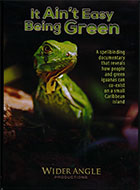
It Ain’t Easy Being Green 2017
Distributed by Green Planet Films, PO Box 247, Corte Madera, CA 94976-0247; 415-377-5471
Produced by Crystal Fortwangler
Directed by Crystal Fortwangler
DVD, color, 35 min.
General Adult
Environmental Protection, Caribbean, Iguanas
Date Entered: 12/18/2017
Reviewed by Andrew Jenks, California State University, Long BeachOn many Caribbean islands, iguanas were first introduced as part of the pet trade in the 1950s or by various colonizers. Not threatened by any native species, and with a ready supply of plants and flowers near human habitation, they have thrived, expanding their population geometrically and ultimately facing the ire of that other invasive species in the Caribbean: human beings. This documentary tells the story of iguanas in the US Virgin Islands. Their population recently took off after another invasive species, the Mongoose that was introduced to keep down rats, suffered a devastating virus that killed up to 80-90 percent of the population.
The short documentary interviews residents and tourists who invariably raise the question of whether humans and iguanas can get along. Few seem sure how to confront the growing population of green iguanas who have gone from being cute to being a constant menace to gardens and fruit trees. Some advocate extermination, others tolerance, and some suggest a culinary solution, given that iguanas taste serviceably like chicken. The documentary explains that iguana populations have soared throughout the Caribbean, forcing Puerto Rico, for example, to engage in mass killings of the lizard and then their export to countries that have a taste for the meat. That is an option, however, that the residents and wildlife managers of the Virgin Islands, as a matter of official policy, have so far rejected.
The playful music and tone of the interviews makes it seem, though this was perhaps not the intent of the film’s producer and director, that the stakes are low in the outcome of this tale of one invasive species (humans) versus another (iguanas). It might have helped to connect the story to the larger problem of invasive species that began with the Columbian Exchange, or to interview more experts on the human-animal relationship and the competition between species for access to and control over natural resources. The question of whether or not humans and iguanas can co-exist thus points to the larger problem of resource limitations. As it is, this documentary provides a relatively light-hearted review of the human-animal problem but the absence of connections to larger themes and issues may limit its usefulness for a classroom setting.